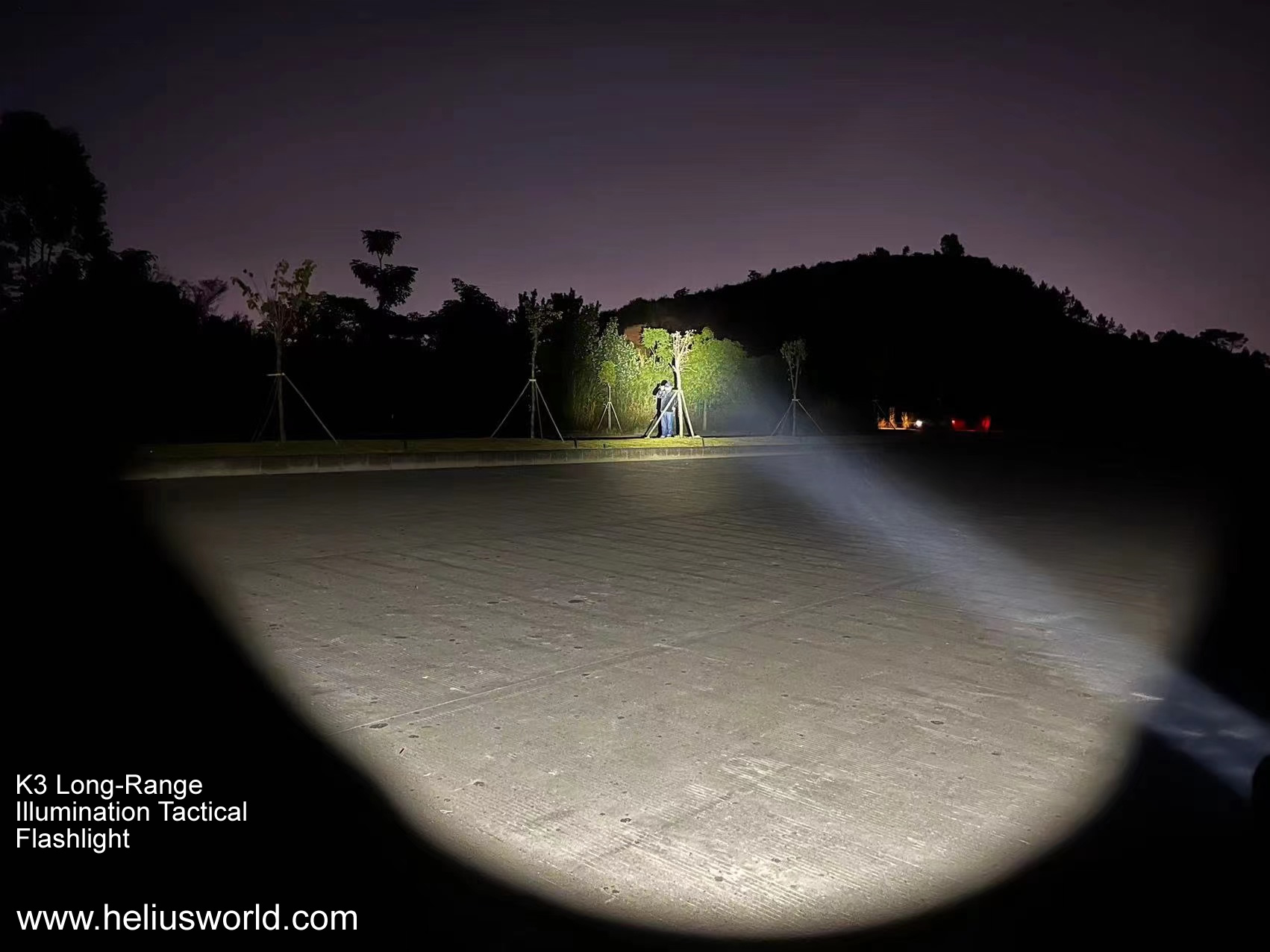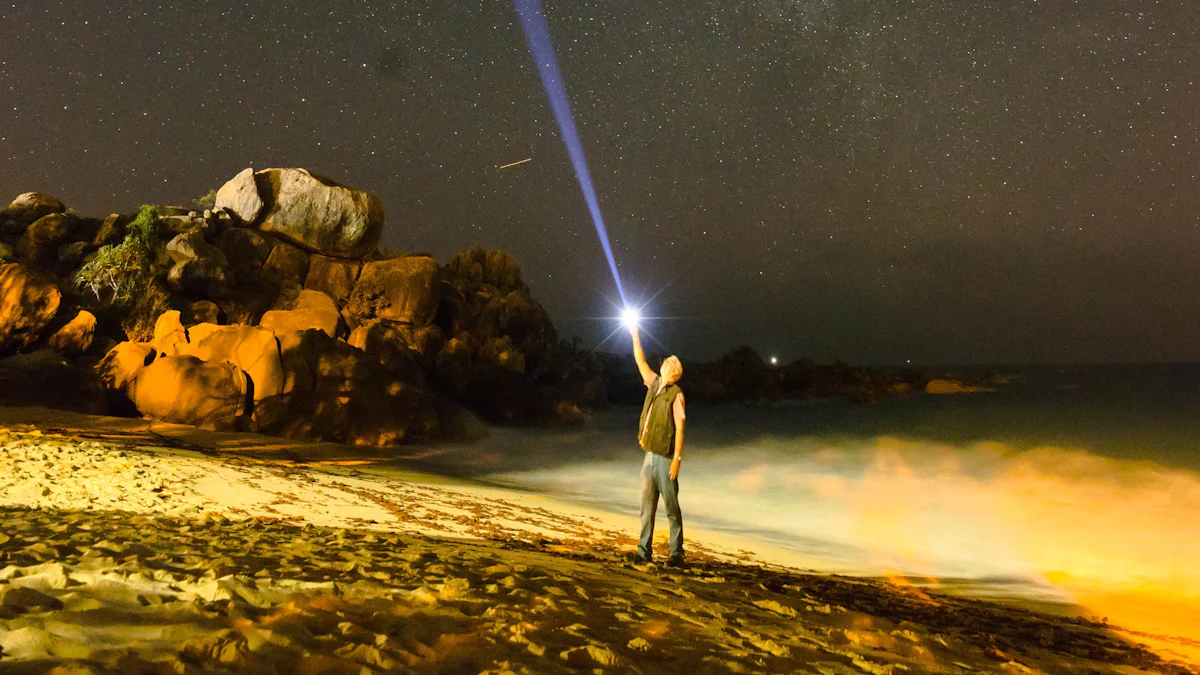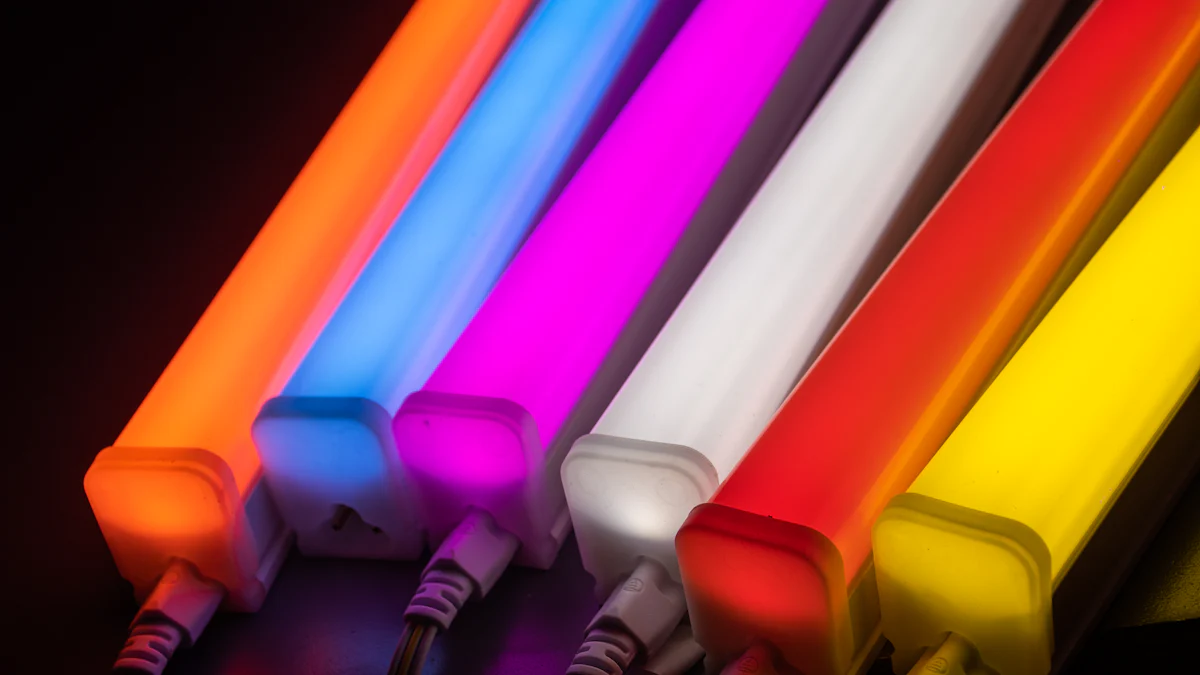Why Color Temperature Matters in Flashlight Design

When choosing a flashlight, you might overlook how its light affects your experience. Color temperature plays a crucial role in this. It determines how well you see objects and how comfortable your eyes feel during use.
Warm light works best in foggy or rainy conditions, making it ideal for outdoor activities.
Cool light enhances visibility over long distances, which is essential for rescue operations.
Neutral light balances both, offering versatility for everyday tasks.
Understanding color temperature helps you select the right flashlight for your needs, whether you're camping, working, or preparing for emergencies.
Key Takeaways
Pick warm light (2700K-3000K) for fog or rain. It cuts glare and helps you see better.
Choose cool light (above 5000K) to see far away. It works well for rescue or searching jobs.
Use neutral light (3500K-5000K) for daily use. It feels natural and is easy on the eyes.
Try flashlights before buying them. See how the light works in real situations.
Think about what you need and where you'll use it. Different jobs need different kinds of light.
Understanding Color Temperature

What Is Color Temperature?
Color temperature refers to the appearance of light emitted by a source, ranging from warm reddish tones to cool bluish tones. It is a critical factor in lighting design because it influences how you perceive your surroundings. Light with a lower color temperature, such as 2700K to 3000K, creates a warm and cozy atmosphere. On the other hand, higher color temperatures, above 5000K, produce cooler light that enhances focus and alertness. This concept is essential for flashlight design, as it determines how well you can see and interact with objects in different environments.
Tip: Warmer light is ideal for relaxing settings, while cooler light works better for tasks requiring precision or alertness.
How Is Color Temperature Measured in Kelvin?
Color temperature is measured in Kelvin (K), a unit based on black-body radiation. A black body is a theoretical object that emits light when heated. The Kelvin scale reflects the temperature of this object and its corresponding light color. Lower Kelvin values, such as 2000K, produce warm, yellowish light. Higher values, like 6500K, result in cool, bluish light. This measurement system has been the standard since the mid-1950s, ensuring consistency across lighting products.
For flashlights, the Kelvin range typically spans from 2700K to 10,000K. Designers use this range to create specific lighting effects. For example, a flashlight calibrated to the color temperature of 4000K offers a neutral white light, balancing warmth and coolness. This balance makes it versatile for various tasks.
The Role of LED Lighting in Color Temperature
LED lighting has revolutionized flashlight design by offering a wide range of color temperatures. Modern LEDs can produce light from 2700K to 6500K, making them suitable for diverse applications. However, achieving this range comes with challenges. For instance, maintaining high color rendering indices above 90 requires advanced LED architectures. Managing heat and ensuring uniform light distribution also demand innovative solutions.
Color Temperature Range | Challenges | Solutions |
|---|---|---|
2700K to 6500K | Maintaining color rendering indices above 90 | Multi-channel LED architectures |
Managing junction temperatures below 85°C | Integrated thermal management | |
Achieving uniform light distribution | Advanced optical mixing techniques |
LED lighting also excels in energy efficiency, making it a sustainable choice. Its ability to provide consistent light output across various color temperatures ensures you get the right illumination for any situation.
Exploring Color Temperature Ranges
Warm White (Below 3,500K)
Warm white light, typically ranging from 2700K to 3000K, creates a cozy and inviting atmosphere. You might recognize this type of light from living rooms, restaurants, or bedrooms, where comfort and relaxation are priorities. Its subtle warmth fosters a sense of tranquility, making it ideal for environments where you want to feel at ease. Unlike cooler lights, which can feel harsh, warm white light enhances the richness of warm tones, making colors appear more vibrant and appealing.
This range of light is not just about aesthetics. It also affects how you perceive your surroundings and your mood. Warm white light can help you feel more relaxed, which is why it works well in spaces designed for social interactions or unwinding after a long day. If you’re using a flashlight with warm color temperatures, it can be particularly useful in foggy or rainy conditions, as the softer light reduces glare and improves visibility.
Neutral White (3,500K to 5,000K)
Neutral white light strikes a balance between warm and cool tones, mimicking natural sunlight. This range is versatile, making it suitable for a variety of tasks. You’ll find it less harsh than cool white light, which makes it comfortable for indoor activities like reading or working. Flashlights in this range are excellent for general-purpose use, offering a natural color rendering that helps you see objects as they truly appear.
Advantages | Disadvantages |
|---|---|
Natural Color - Mimics sunlight | Not the brightest option |
Less Harsh than Cool White | Limited in some application scenarios |
Good for Indoor Activities | |
General Purpose Use | |
Useful in Hospitals |
If you need a flashlight for everyday tasks, neutral white light provides a practical solution. It offers enough brightness without overwhelming your eyes, making it a reliable choice for most situations.
Cool White (Above 5,000K)
Cool white light, with its bright and intense output, excels in high-contrast environments. This range enhances visibility, making it perfect for outdoor activities, search and rescue operations, and emergency scenarios. You’ll notice how it creates distinct color contrasts, which helps you identify objects and colors more easily in low-light conditions.
Flashlights with cool color temperatures are particularly effective in industrial work or law enforcement, where precision and clarity are critical. The crisp, bluish light can cut through darkness, providing the illumination you need to focus on details. While it may feel stark compared to warmer tones, its functionality in demanding environments makes it indispensable.
Tip: Use cool white light when you need maximum brightness and clarity, especially in outdoor or tactical situations.
Why Color Temperature Matters in Flashlight Design
Visibility and Object Identification
Color temperature directly affects how well you can see and identify objects in different environments. Flashlights with warm color temperatures excel in foggy or rainy conditions. Their softer light reduces glare and enhances contrast, making it easier to spot obstacles or landmarks. On the other hand, cool color temperatures provide bright, crisp illumination. This makes them ideal for long-distance visibility, such as during search and rescue missions or nighttime navigation. Neutral white light offers a balanced solution, helping you perceive colors accurately without overwhelming your eyes. Choosing the right color temperature ensures you can see clearly, no matter the situation.
Task-Specific Applications
Different tasks require specific lighting solutions. For outdoor adventures like camping or hiking, neutral or warm light creates a comfortable and natural atmosphere. In contrast, tactical or emergency scenarios demand the precision and brightness of cool light. LED lighting allows flashlights to cater to these diverse needs. For example, a flashlight with adjustable color temperature can switch between warm and cool tones, adapting to your environment. This flexibility makes LED lighting a versatile tool for professionals and everyday users alike. By selecting the appropriate light, you can enhance your efficiency and safety during any activity.
User Comfort and Eye Strain
The impact on mood and eye comfort is another critical factor in flashlight design. Warm light promotes relaxation and reduces eye strain, making it suitable for prolonged use. Cool light, while excellent for focus, can feel harsh over time. Neutral light strikes a balance, offering comfort without sacrificing visibility. LED lighting excels in energy efficiency, ensuring consistent light output without flickering. This stability minimizes discomfort and enhances your overall experience. Understanding how color temperature influences comfort helps you choose a flashlight that supports your needs while protecting your eyes.
Practical Applications of Color Temperature

Outdoor Activities and Adventures
When you venture outdoors, the right flashlight can make all the difference. Warm color temperatures, ranging from 2700K to 3500K, are excellent for activities like camping or hiking in foggy or rainy conditions. This type of light reduces glare and enhances contrast, helping you navigate challenging environments. Neutral white light, between 3500K and 5000K, mimics natural sunlight. It provides a balanced beam that works well for general outdoor use, such as setting up tents or cooking at night. Cool white light, above 5000K, is ideal for long-distance visibility. It helps you spot trails, wildlife, or landmarks in the dark. By choosing a flashlight with adjustable LED lighting, you can adapt to different outdoor scenarios with ease.
Emergency and Tactical Scenarios
In emergencies, every second counts. Flashlights with cool white light excel in these situations. Their bright, bluish beam cuts through darkness, making it easier to locate people or objects. This is especially useful in search and rescue operations or tactical missions. LED lighting ensures consistent brightness and energy efficiency, so your flashlight won’t fail when you need it most. For close-range tasks, such as reading maps or administering first aid, neutral white light offers clarity without overwhelming your eyes. Some flashlights even allow you to switch between color temperatures, giving you the flexibility to handle various challenges. Whether you’re a first responder or preparing for power outages, selecting the right lighting solutions can enhance your safety and effectiveness.
Everyday Carry (EDC) Flashlights
Everyday carry flashlights are designed for versatility. Warm light, between 2700K and 3500K, is perfect for close-range tasks in dark environments. It reduces eye strain and creates a comfortable viewing experience. Cool light, above 5000K, is better for illuminating distant objects, making it useful for nighttime walks or inspecting hard-to-reach areas. LED lighting in EDC flashlights ensures energy efficiency, so you can rely on them for extended use. Many models offer adjustable color temperature settings, allowing you to tailor the light to your needs. Whether you’re using your flashlight for quick repairs, outdoor exploration, or personal safety, understanding color temperature applications helps you make the best choice.
Choosing the Right Flashlight Based on Color Temperature
Assessing Your Needs and Environment
Start by identifying how and where you plan to use your flashlight. Outdoor activities like hiking or camping often require bright, high-contrast lighting. Cool white flashlights work best in these scenarios because they enhance visibility and color contrast. For indoor tasks, such as reading or repairing small items, neutral white light provides natural color reproduction and reduces eye strain. If you frequently encounter foggy or rainy conditions, warm white light offers better visibility by cutting through glare. Consider your typical environment and tasks to narrow down your options.
Comparing Flashlights and Testing Beam Colors
Testing flashlights before purchasing ensures you find the right match. Look for models with adjustable beam settings or multiple color temperature options. Shine the flashlight on different surfaces to observe how the light interacts with colors and textures. Pay attention to how your eyes feel under each beam. Cool white beams appear brighter and sharper, while neutral white beams feel more balanced. Warm white beams create a softer, more comfortable glow. Testing helps you understand how each beam performs in real-world conditions, making it easier to choose the best lighting solutions for your needs.
Color temperature plays a vital role in flashlight design, shaping how you perceive light and interact with your environment. Warm light reduces eyestrain in dark settings, while cool light enhances visibility for distant objects. High CRI flashlights are essential for tasks like photography, where accurate color differentiation matters. Your choice of lighting solutions should reflect your specific needs and preferences. Whether you’re navigating foggy trails or working on detailed tasks, understanding these differences ensures you select the best flashlight for any situation.
FAQ
What is the best color temperature for outdoor activities?
For outdoor activities, neutral white light (3,500K to 5,000K) works well. It mimics natural sunlight, helping you see objects clearly. If you’re navigating foggy or rainy conditions, warm white light below 3,500K reduces glare and improves visibility.
Can I adjust the color temperature on all flashlights?
Not all flashlights allow you to adjust the color temperature. Some advanced models offer adjustable settings, letting you switch between warm, neutral, and cool light. These lighting solutions provide flexibility for different tasks and environments.
How does color temperature affect eye comfort?
Warm light reduces eye strain during prolonged use. Cool light enhances focus but may feel harsh over time. Neutral light balances both, offering comfort and clarity. Choosing the right color temperature ensures a better experience for your eyes.
Why is color temperature important in tactical flashlights?
Tactical flashlights often use cool white light above 5,000K. This bright, crisp light enhances visibility and contrast, making it easier to identify objects in low-light conditions. It’s essential for search and rescue missions or emergency scenarios.
What does “color temperature of the booth” mean?
The color temperature of the booth refers to the lighting used in enclosed spaces like exhibition booths. It affects how objects and colors appear. Flashlights with neutral or cool light can replicate this effect, ensuring accurate color rendering.
See Also
A Complete Guide to Selecting Color Flashlights for Outdoors
Selecting the Ideal Color Flashlight for Hog Hunting
Green vs. White Light Flashlights: Which Is Better for Hunting?
